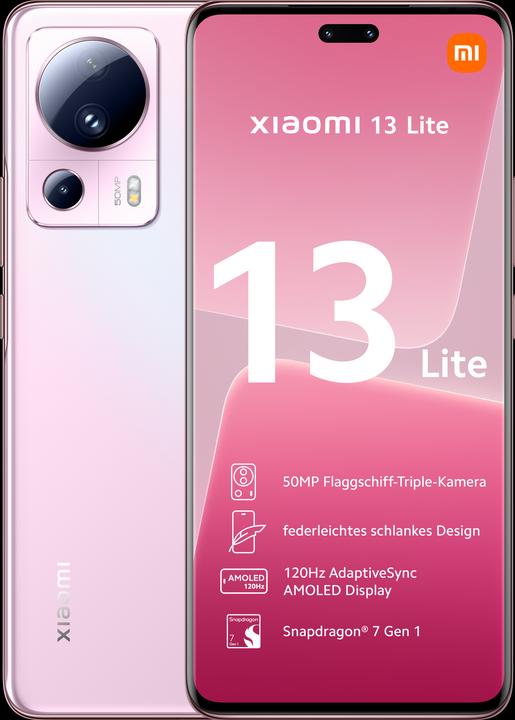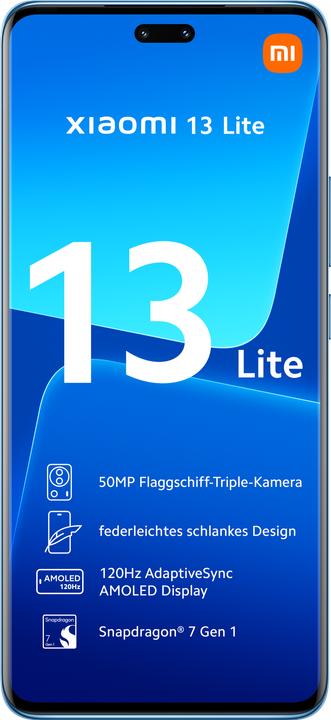

Xiaomi 13 Lite put to the test: update policy diminishes overall good impression
Slim, light, smart – during my test, the Xiaomi 13 Lite impresses with its mid-range elegance. But let’s cut to the chase: does its camera system offer more than usual?
Even though it’s not particularly small, the Xiaomi 13 Lite feels nice and light in your hand. This mid-range smartphone’s equipped with a 6.55-inch screen. But it’s still pretty lightweight at 171 grammes. And with a thickness of 7.23 millimetres, it’s exceptionally slim.
The light and airy feel the device has is further enhanced by its rounded edges. They feel really nice. Especially compared to the countless clunky phones that hit the market. And despite its slippery back and smooth edges, the phone is easy to grip.
The 13 Lite currently costs around 450 francs or a bit more than 400 euros. However, the phone feels like it’s much higher quality when you put it to daily use. This impression is further fuelled by the Amoled screen. Its 6.55 inches pack 1,080 by 2,400 pixels. The beautiful colours are striking. And with up to 1,000 nits of brightness, you should be sorted for outdoor use.
Xiaomi has also cleverly hidden the edges that aren’t quite as thin. They’re tucked away under the rounded glass edges, which renders them almost invisible. The refresh rate either dynamically switches between 60 and 120 hertz, or you can select one of the two values. The fingerprint sensor below the screen is surprisingly speedy and precise.
In other words, the touch and feel of the phone are clearly above average in its price range. Having said that, most mid-range devices reveal one or two weaknesses when it comes to photography and filming. It’s these areas that usually display visible differences compared to the flagships. But how does the 13 Lite fare?

Source: Lorenz Keller
Subtleties lost in challenging lighting conditions
In this test, I compared the pictures to those taken with the Google Pixel 7 Pro – currently one of the best camera phones on the market. Both test devices took the pictures automatically in the respective mode without any readjustment.
Let’s begin with close-ups. After all, the Xiaomi has a separate 2-megapixel sensor for macro shots. The sensor makes sure the petals on the photo are sharp in the centre and the background’s pleasantly blurry. Compared to the Pixel, however, a lot of details are lost. The colours are also much more natural on the Google phone.

Source: Lorenz Keller

Source: Lorenz Keller
Time to bring on the next challenge for the two cameras. I took a photo facing the sun with the main camera and the wide angle. Both devices deliver astonishing results given the tricky lighting.
The Xiaomi’s main camera keeps up surprisingly well. Admittedly, the software cranks up the colours a bit. The blues and greens are gaudier than in real life. But when it comes to details, the two 50-megapixel sensors are similarly strong. Only if you look closely and enlarge the photos, you’ll notice that the Xiaomi depicts the water bubbles as a white surface and the Google Pixel captures much more light and shadow.

Source: Lorenz Keller

Source: Lorenz Keller
I immediately notice the big colour difference in the next pictures. The picture taken with the 13 Lite’s wide-angle camera is greener than the one taken with its main camera. With the Google phone, the difference is much more subtle. Xiaomi’s 8-megapixel sensor doesn’t stand a chance in other areas, either. For example, many details of the reeds lining the shore are lost. Instead, it looks more like dark green mush.

Source: Lorenz Keller

Source: Lorenz Keller
You can also see these differences in greater detail in the last example of pics taken in difficult lighting conditions. The Pixel manages to capture more subtleties of the interplay between the bright sunlight and shady reeds. Nevertheless, the Xiaomi also does a good job.
And there you have the verdict of the camera comparison. For everyday use, the Xiaomi 13 Lite should suffice to take good photos in most conditions. The better the lighting conditions, the smaller the differences to a flagship. I’d give minus points for small things such as the default soft focus for the selfie cam.

Source: Lorenz Keller

Source: Lorenz Keller
By contrast, the night mode is impressive. In this mode, the Xiaomi has no problem keeping up with the Google Pixel that costs twice as much. The phones were put to a classic test. Namely taking a picture of an illuminated building with dark surroundings. In other words, where the differences between light and dark are extreme.

Source: Lorenz Keller

Source: Lorenz Keller
While the video quality is also only mediocre, the microphones produce surprisingly good sound recordings and cleverly filter out the wind. In the short sample videos, you can clearly see that the camera doesn’t stabilise any movements much. You’ll also notice that the video quality drops significantly as soon as the lighting conditions aren’t so good any more. For example, when I filmed against the sun.
Battery OK, chip OK, software meh
The biggest drawback of the compact and slim design? With its 4,500 mAh, the battery is smaller than many competitors that rely on 5,000 mAh. However, the battery life is excellent. Fast charging with the included 67-watt charger is also a plus. During the test, the 13 Lite charged from 30 to 100 per cent in just over 30 minutes. Unfortunately, there’s no wireless charging.
The phone relies on the Snapdragon 7 Gen 1 with 8 GB of working memory as its processor. As to be expected, the mid-range chip, which was introduced a year ago, also came out very mediocre in the benchmarks. Compared to the Samsung Galaxy A54 with Exynos 1380 processor, which costs roughly the same, it fared even slightly worse.
But it absolutely does the job in daily use. The system runs smoothly and the apps start up quickly. I didn’t notice any jerks in the test. I even managed to play a racing game with fast graphics changes on it without any problems.
When it comes to the software, however, I’m not particularly enthusiastic. The fact that the device comes with Android 12, although Android 13 has been available since autumn, is downright bizarre. At least there’s now an update for the latest Android version available. However, it will also make you lose an Android update. Xiaomi only guarantees upgrades until Android 14, which is way less than what many competitors offer. On the upside, there will be security updates until at least August 2026.
The MIUI user interface features many preinstalled apps and games, which, fortunately, can be deleted. Otherwise, it’s clearly arranged, runs fast, but is still very far removed from pure Android. And whether you like that or not is just a matter of taste.

Source: Lorenz Keller
Verdict: expect quality with some big question marks
The look, design and finish are excellent. The Xiaomi 13 Lite also has many other features that make for a good overall impression. Its camera system is also good considering the price bracket, which makes the device a real alternative in the mid-range sector.
However, the price range spanning 400 to 500 francs is teeming with competitors. I already spoke about the Samsung Galaxy A54. And Xiaomi even has company-internal competition with the Redmi Note 12 Pro+.
The 13 Lite would have scored even better overall if the manufacturer had been a bit more generous with the updates. This is especially important for everyone who plans on using their device for a longer period of time.
Header image: Lorenz KellerGadgets are my passion - whether you need them for the home office, for the household, for sport and pleasure or for the smart home. Or, of course, for the big hobby next to the family, namely fishing.






